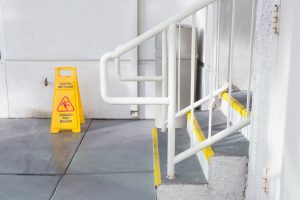 Slip and fall personal injury claims can be more complex than you would think. In addition to questions about whether there was a dangerous condition and whether the property owner knew or should have known about it and failed to remedy it, there may be multiple parties legally responsible for the claim.
Slip and fall personal injury claims can be more complex than you would think. In addition to questions about whether there was a dangerous condition and whether the property owner knew or should have known about it and failed to remedy it, there may be multiple parties legally responsible for the claim.
The victim must be able to prove who was responsible for your injuries and whether or not that party (or parties) was negligent. In order for liability to be proven in a slip and fall claim, the injured party must prove one of the following:
- A property owner (or employee) should have recognized a dangerous condition and repaired or removed the potential danger and failed to do so.
- A property owner (or employee) actually caused the dangerous condition that led to the slip and fall injury, and it was reasonably foreseeable that someone would fall and get hurt.
Slip and fall claims can be difficult to prove because the defendant (or its insurance company) often tries to place the blame on the injured party. An experienced slip and fall attorney understands the insurance company’s strategy and how to combat it to ensure that he gets his clients the compensation they deserve.
Premises Liability Cases
Slip and fall claims fall under the legal principle known as “premises liability”. With these cases, the laws of negligence apply, so a key question is: “Who is at fault?” In cases in which more than one party can be held liable, you may file a claim against:
- Property owner
- Property manager
- Employee
- HOA (homeowners association)
- Rental company
- County or state agency (municipality that owns or maintains the road, building, sidewalk, or park where you sustained your injuries)
The elements of negligence apply with premises liability cases: Duty, breach of duty, causation, and damages. Property owners owe a duty of care to people who will come onto their property, and when the property is a business, the owners owe the highest duty of care to their customers and other visitors. It is the property owner’s duty to make sure the building and surrounding areas are safe and secure for their business invitees.
Examples of negligence on the part of a business owner include:
- Uneven surface
- Defective staircase
- Unsecured rug
- Wet floors
- Hidden holes
- Obstacles in pathway
- Lack of signage
- Hidden cords/wiring
- Loose or broken floors, sidewalks, or steps
- Lack of security at night
- Poor or non-existent lighting
- Icy, snowy walkways and doorways
After a Slip and Fall Insurance Claim is Filed
As with most personal injury claims, the process of working through a slip and fall insurance claim is a long one. Once your personal injury attorney files a claim, he will then file a demand package, which includes:
- Details of the slip and fall (where it took place, when, etc.)
- Description of injuries sustained in the fall
- Summary of the medical treatment necessary since the fall
- List of medical bills for said treatment
- Monetary demand for settlement, which is dependent upon the amount of insurance coverage available to satisfy the claim, the cost of medical treatment, the severity of injuries sustained, and the damages suffered
When the insurance company for the defendant receives the demand package, one of two things will happen next: 1) A settlement offer will be made or 2) The insurance company will deny liability altogether. Your attorney (and you) will then decide the next step, which may be a counter offer if the defendant’s insurance company offered a number that’s too low, or your lawyer may decide to file a lawsuit. Keep in mind that over 90% of personal injury claims are settled out of court, so you will probably settle, too, before ever seeing a courtroom.
If the defendant’s insurance company disputes liability, your attorney will have to prove liability. Offers followed by counter offers may take several months or years. It is important to remember that filing a lawsuit is just part of the process and it does not mean your case will actually go to trial. Premises liability claims can be settled at any time prior to trial.
